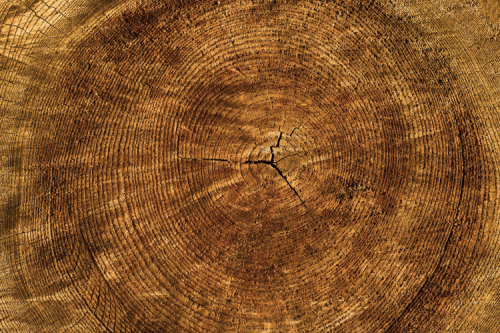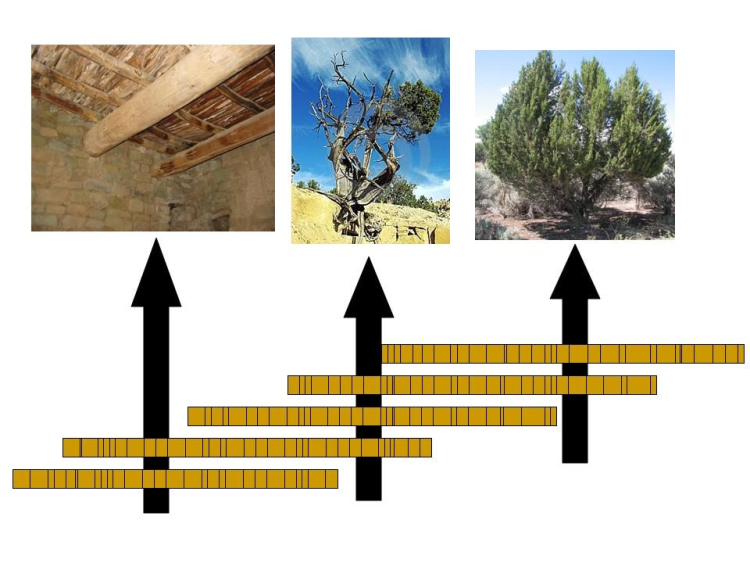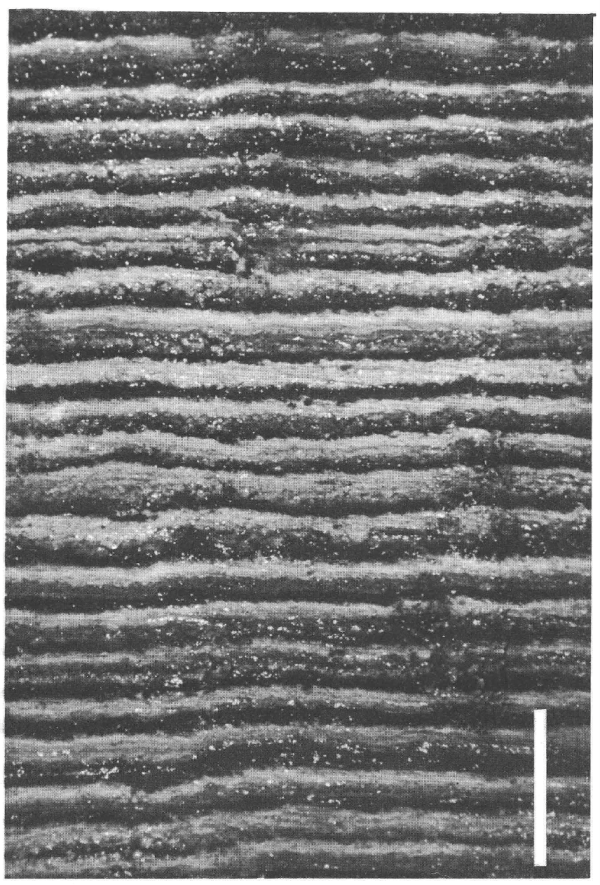Dating with Tree Rings and Other Annual Layers
Video: Dating with Annual Layers (3:39 minutes)
Trees make annual layers, and some sedimentary deposits also have annual layers. The longest annual records extend much older than written histories, although they capture only a very small part of Earth’s long history. In this Module, we start with annual layers and then continue to look at other ways to learn the ages of events in Earth’s history. If you like video versions, here’s a short intro.
In a seasonal environment, a tree reliably produces a visible growth ring each year. The reasons for this behavior are well-understood, and the annual nature of the rings has been checked many, many times. Rarely, there is a problem (a piece of a ring may be missing if the tree was damaged, perhaps by a fire or a burrowing beetle, and a late frost or other odd event may make a ring look strange), but tree-ring daters (dendrochronologists) have learned to recognize these events. In general, tree-ring dating can be practiced with no errors. Many, many tests have been conducted to confirm that this works, that the results match historical records, etc. Most such sampling is done using narrow coring devices, and does not harm the trees.


In studying tree rings, one sees that the width is not the same from year to year. Thick rings grow during “good” years, and thin rings during bad years. This allows tree rings to be used to reconstruct past climates. In a dry area, a good year is a wet one, so tree rings can be used to find out how much rain fell in the past. In a cold area, a good year is a warm one, so the tree rings function as thermometers.
For our purposes here, the pattern of good and bad years (fat and thin rings) is important for dating. On Wheeler Peak, and in the White Mountains and elsewhere, dead trees occur near the living bristlecones. Some of these dead trees sprouted before the living ones and overlapped in age with the still-living trees. Other dead trees can be found in archaeological sites or buried in sediments. A tree-ring specialist can start by dating the good and bad years using living trees. The specialist can then find the same pattern of thick and thin rings in overlapping years of the dead tree, and so use the dead tree to extend the record back to when the dead tree first sprouted (see the figure below). By overlapping a few long-lived trees, or many short-lived trees, very long chronologies can be generated.

So How Many Layers?
Such techniques are used to date archaeological sites, including those of the Ancestral Puebloan peoples (also sometimes called the Anasazi; at Mesa Verde and several other national parks). For example, the Cornell Tree-Ring Laboratory, long directed by the great Professor Peter Ian Kuniholm and now being carried forward by a new generation, has for decades been doing amazing work using tree rings to understand classical history in the Aegean region, the Middle East, and elsewhere, confirming, refining, and extending historical accounts. The beautiful agreement between tree-ring and historical accounts as far back as the oldest reliable written records confirms the accuracy of the techniques.
But, the tree-ring records extend well beyond reliable written histories. The longest tree-ring record in the U.S. Southwest is now more than 8000 years. The longest record anywhere in the world is from tree trunks buried along rivers in north Germany, and extends to 12,429 years—before that, closer to the heart of the ice age, conditions were too cold for trees in that region of Germany, including times when the area was under massive ice-age glaciers. Because most trees live for “only” centuries rather than millennia, such records (and a few other really long ones, such as a 7,272-year record that was completed in 1984 from oak logs buried in Irish bogs) represent immense investments of time and effort, and people have devoted whole careers to assembling these outstanding records. Notice that there is a lot of older wood, some of it much older, including the fossil trees at Yellowstone, in the Petrified Forest, and elsewhere. The more than 12,000 years in Germany are the longest continuous record reaching the present, but surely do not come anywhere close to including the whole history of trees.
Other Annually Layered Deposits
Several other types of annually layered deposits exist. For example, some lakes in cold regions freeze every winter. When the lake is thawed in the summer, sand and gravel are washed in by streams. When the lake and its surroundings freeze, the streams slow or stop, and the only sediment settling to the lake bottom is the very fine silt and clay particles that were washed in during the summer but require months to fall. A coarse layer capped by a fine layer forms each year. Such a yearly coarse-fine layer pair is called a varve. Many such varved lakes have been studied, and found to contain thousands of years to more than 14,000 years. Many of these lakes occur in glacier-carved basins, and so their records extend only back to the time when the glacier ice melted.

Lake Suigetsu, in Japan, has a spring bloom of diatoms—algae with silica "shells"—that make a light-colored layer, alternating with darker mud washed into the lake during the rest of the year. More than 45,000 annual layers have been counted in that lake, although some interpolations were needed in a few places in the cores.
Note that most lakes lack annual layers. If there is a lot of oxygen in the deep waters, worms will thrive in the mud beneath, and their burrows may disturb the layers. If the lake is shallow, waves may disturb the deep muds. But enough lakes exist with annual layers to be useful. And, simply seeing layers doesn’t prove they are annual; lots of tests have to be done, some of which we describe below when we discuss annually layered ice cores.
Cave formations often have annual layers. And, a few other types of sediments, including certain corals, can have annual layers. Again, a lot of work goes into showing that the layers are annual, and into interpreting them accurately.